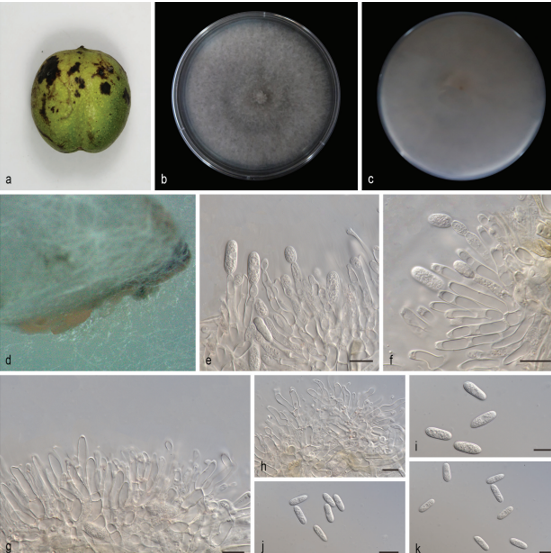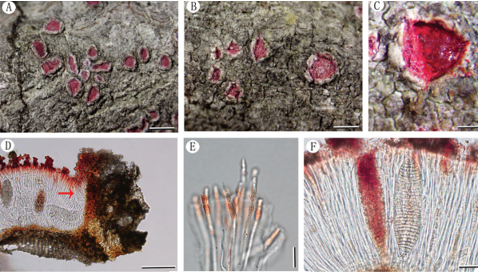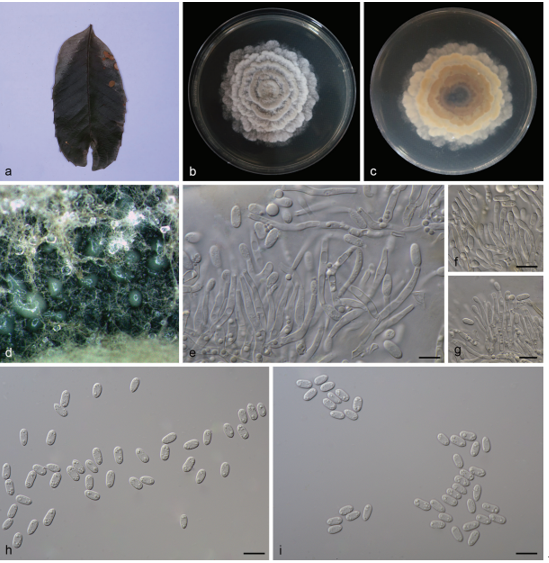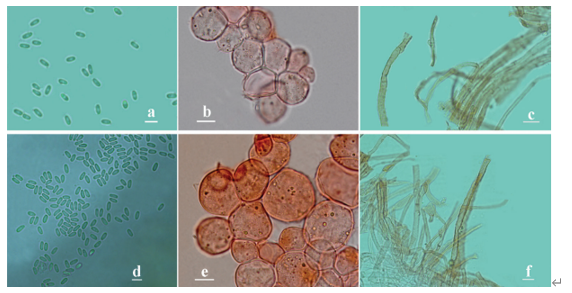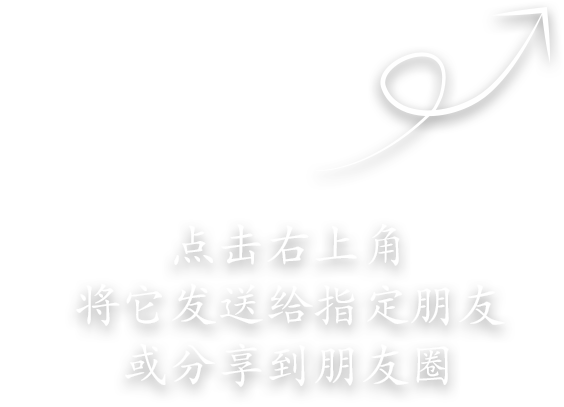Neohelicascus submersus H. Yang, W. Dong, K.D. Hyde & H. Zhang, sp. nov.2020
Index Fungorum number: IF557927; Facesoffungi number: FoF09269
Holotype: CHINA, Yunnan Province, a small river in Puzhehei wetland, on submerged wood, 23 June 2019, H. Yang, P36 (MFLU 20-0436, holotype), ex-type living culture KUMCC 20–0153.
Morphological description
Saprobic on submerged wood. Sexual morph: Pseudostromata 485–540 μm high, 315–510 μm diam., scattered, comprising dark brown to black fungal tissues growing in cortex of host, immersed, unilocular, lenticular, flattened at the base, black, with wide ostiole, visible as elongate, prominent, black neck erumpent on the host surface. Neck 310–320 × 125–165 μm, central, cylindrical, with periphyses. Peridium 20–45 μm thick, comprising several layers of dark brown cells of textura epidermoidea. Pseudoparaphyses 1.5–2.5 μm wide, numerous, cellular, cylindrical, hyaline, indistinctly septate. Asci 120–165 × 17.5–21 μm ( x̄ = 143 × 19 μm, n = 10), 8-spored, bitunicate, fissitunicate, cylindrical to narrowly clavate, apically rounded, base of endoascus long, narrow and coiled within ectoascus, up to 150 μm long. Ascospores 23.5–31 × 8.5–11.5 μm, ( x̄ = 27 × 10 μm, n = 30), obliquely arranged, overlapping uniseriate or occasionally biseriate, ellipsoidal to fusiform, slightly curved, 1-septate, constricted at the septum, upper cell slightly wider than lower cell, hyaline when young, become brown when mature, guttulate, thin-walled, smooth, covered by a distinct gelatinous sheath, 1.5–5.5 μm wide, showing 15–27 μm wide in Indian Ink. Asexual morph: Undetermined.
Cultural characteristics: Conidia germinated on PDA within 24 hours. Germ tubes arising from end of the ascospore. Colonies on PDA reaching 30 mm diameter in 30 days at 20–25 °C, initially white, turning reddish brown to dark brown after 15 days, with dense, hairy mycelium on the surface, with undulate, red margin, reverse reddish brown.
Habitat: submerged wood
Distribution: CHINA,
GenBank Accession: MFLU 18-1170
Notes: Neohelicascus submersus forms a well-supported clade with four species N. elaterascus, N. egyptiacus, N. unilocularis and N. uniseptatus (Fig. 84). Neohelicascus submersus resembles N. elaterascus in having unilocular pseudostromata, and ellipsoidal to fusiform, brown ascospores with a distinct gelatinous sheath (Shearer 1993b). However, N. elaterascus has shorter and wider asci (95–149 × (14–)18–25(–38) μm vs. 120–165 × 17.5–21 μm) and ascospores are mostly biseriate and verrucose in the holotype C-76-1 (Shearer 1993b). Our two collections of N. elaterascus (MFLUCC 18-0993 and MFLUCC 18-0985) have smooth ascospores, which are similar to N. submersus, but phylogenetic analysis separate them as distinct species (Fig. 84).
Reference: Freshwater Dothideomycetes are a highly diverse group of fungi, which are mostly saprobic in freshwater habitats worldwide. They are important decomposers of submerged woody debris and leaves in water. In this paper, we outline the genera of freshwater Dothideomycetes with notes and keys to species. Based on multigene analyses and morphology, we introduce nine new genera, viz. Aquimassariosphaeria, Aquatospora, Aquihelicascus, Fusiformiseptata, Neohelicascus, Neojahnula, Pseudojahnula, Purpureofaciens, Submersispora; 33 new species, viz. Acrocalymma bipolare, Aquimassariosphaeria kunmingensis, Aquatospora cylindrica, Aquihelicascus songkhlaensis, A. yunnanensis, Ascagilis submersa, A. thailandensis, Bambusicola aquatica, Caryospora submersa, Dictyocheirospora thailandica, Fusiformiseptata crocea, Helicosporium thailandense, Hongkongmyces aquaticus, Lentistoma aquaticum, Lentithecium kunmingense, Lindgomyces aquaticus, Longipedicellata aquatica, Neohelicascus submersus, Neohelicomyces dehongensis, N. thailandicus, Neohelicosporium submersum, Nigrograna aquatica, Occultibambusa kunmingensis, Parabambusicola aquatica, Pseudoasteromassaria aquatica, Pseudoastrosphaeriella aquatica, Pseudoxylomyces aquaticus, Purpureofaciens aquatica, Roussoella aquatica, Shrungabeeja aquatica, Submersispora variabilis, Tetraploa puzheheiensis, T. yunnanensis; 16 new combinations, viz. Aquimassariosphaeria typhicola, Aquihelicascus thalassioideus, Ascagilis guttulaspora, A. queenslandica, A. seychellensis, A. sunyatsenii, Ernakulamia xishuangbannaensis, Neohelicascus aquaticus, N. chiangraiensis, N. egyptiacus, N. elaterascus, N. gallicus, N. unilocularis, N. uniseptatus, Neojahnula australiensis, Pseudojahnula potamophila; 17 new geographical and habitat records, viz. Aliquandostipite khaoyaiensis, Aquastroma magniostiolata, Caryospora aquatica, C. quercus, Dendryphiella vinosa, Ernakulamia cochinensis, Fissuroma neoaggregatum, Helicotruncatum palmigenum, Jahnula rostrata, Neoroussoella bambusae, N. leucaenae, Occultibambusa pustula, Paramonodictys solitarius, Pleopunctum pseudoellipsoideum, Pseudocapulatispora longiappendiculata, Seriascoma didymosporum, Shrungabeeja vadirajensis and ten new collections from China and Thailand, viz. Amniculicola guttulata, Aquaphila albicans, Berkleasmium latisporum, Clohesyomyces aquaticus, Dictyocheirospora rotunda, Flabellascoma fusiforme, Pseudoastrosphaeriella bambusae, Pseudoxylomyces elegans, Tubeufa aquatica and T. cylindrothecia. Dendryphiella phitsanulokensis and Tubeufa roseohelicospora are synonymized with D. vinosa and T. tectonae, respectively. Six orders, 43 families and 145 genera which belong to freshwater Dothideomycetes are reviewed. Of these, 46 genera occur exclusively in freshwater habitats. A world map illustrates the distribution of freshwater Dothideomycetes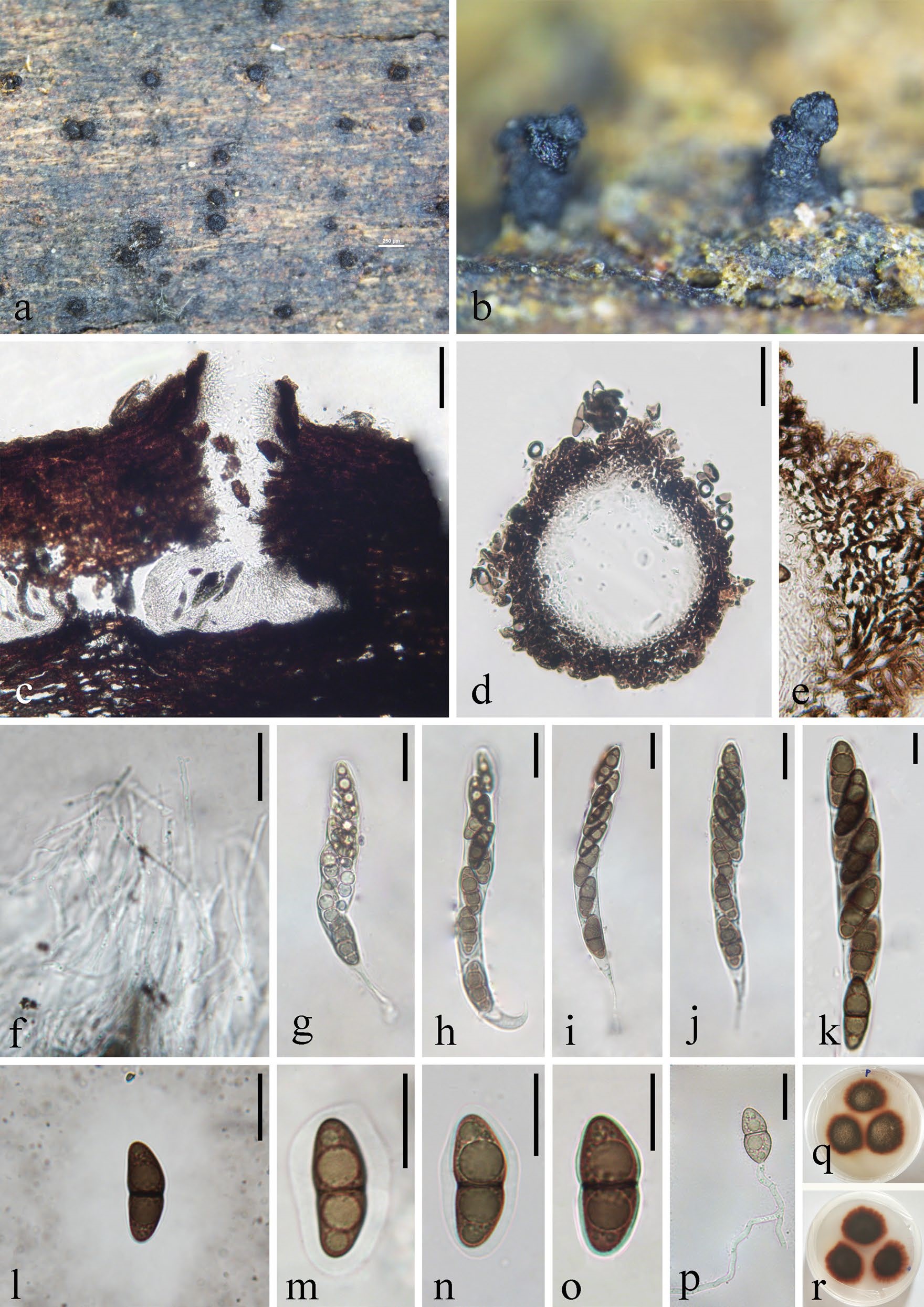
Neohelicascus submersus (MFLU 20-0436, holotype). a, b Bitunicate asci. l–o Ascospores. p Germinated ascospore. q, r Colony Immersed pseudostromata with blackened neck. c, d Vertical section on PDA (up-front, down-reverse). Scale bars: c = 100 μm, d = 50 of pseudostroma. e Structure of peridium. f Pseudoparaphyses. g–k μm, e–j, l–p = 20 μm, k = 10 μm
Fig. 84 Phylogram generated from maximum likelihood


